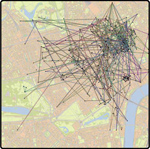:: Tuesday, May 10, 2005 ::
 NAR REVIEW: BLAST THEORY
NAR REVIEW: BLAST THEORY
BY: Ana Boa-Ventura
GPS and other mobile devices are questioning in an unprecedented way conceptual splits between the 'real' and on-screen spaces. 'Mixed reality' is the term used to designate this new art and research field where reality and the virtual are connected through mostly mobile and wireless technologies. While these new technologies are being used by the military and entertainment industries, gaming art seems to be the perfect hybrid and it's not surprising, then, that the British, long leaders in navigation and theater are doing the most innovative work. Some of their performance groups are establishing collaborations with university research centers and labs to provoke new directions for mobile technologies, their implementation and use.
An especially lasting and rewarding collaboration: Blast Theory, performance artists and makers of the urban game, 'I Like Frank' and the Mixed Reality Lab at the University of Nottingham work on the production of excellent game-like event-based art, such as 'Can You See Me Now?' and 'Desert Rain'.In 'Can You See Me Now?' online players chat through text and are pursued by street players with GPS receivers and PDAs. The strategy element makes this mixed reality project feel like a game.
The Blast Theory/MRL research has resulted in a company - EverPresence- with a bold, 'commercial' agenda between the collaborators. They propose to realize the ideas of their clients'through new location-based and mobile services by combining the company's game engine and 'positioning technologies' with standard tools such as Shockwave and Flash.
URLs:
EverPresence: http://www.everpresence.co.uk/
Mixed Reality Lab (University of Nottigham): http://www.mrl.nott.ac.uk/
Blast Theory: http://www.blasttheory.co.uk/
Can you See me Now? : http://www.blasttheory.co.uk/bt/work_cysmn.html
 PROJECT HIGHLIGHT::
PROJECT HIGHLIGHT::URBAN TAPESTRIES
Experimenting with Urban Space and ICTs
Techniques of Collaboration
Urban Tapestries focuses on asynchronous human interactions in the urban environment, developing a layer of wireless communications to support the sharing of 'social knowledge'. A key aspect of our collaboration has been monthly day-long meetings where the core team has assembled together to brainstorm and bodystorm key issues and ideas. An important part of these meetings has been social - cooking and eating together; taking time out from the 'work' to participate in a group activity based on community and sharing. Such activities may seem trivial, but are often a necessary distraction in the process of overcoming a problem and cohere a group dynamic that is not solely based on work. Innovation often relies on oblique solutions to problems - requiring a flexible and fluid structure for creative thinking and reflection.
To support our own collaboration we also make extensive use of a Wiki and mailing lists to share information and research findings between remote participants as well as to discuss project development. Proboscis has set up a streaming server (using Apple's open source Quicktime Broadcaster & Darwin Streaming Server) to stream live project meetings to remote participants, and using instant messaging and audio chat as a backchannel. Added to face-to-face meetings, these technologies provide a powerful set of tools to short-circuit distance and physical barriers, as well as supporting an openness of knowledge and information within the group. --UT
Urban Tapestries Weblog
http://urbantapestries.net/weblog/